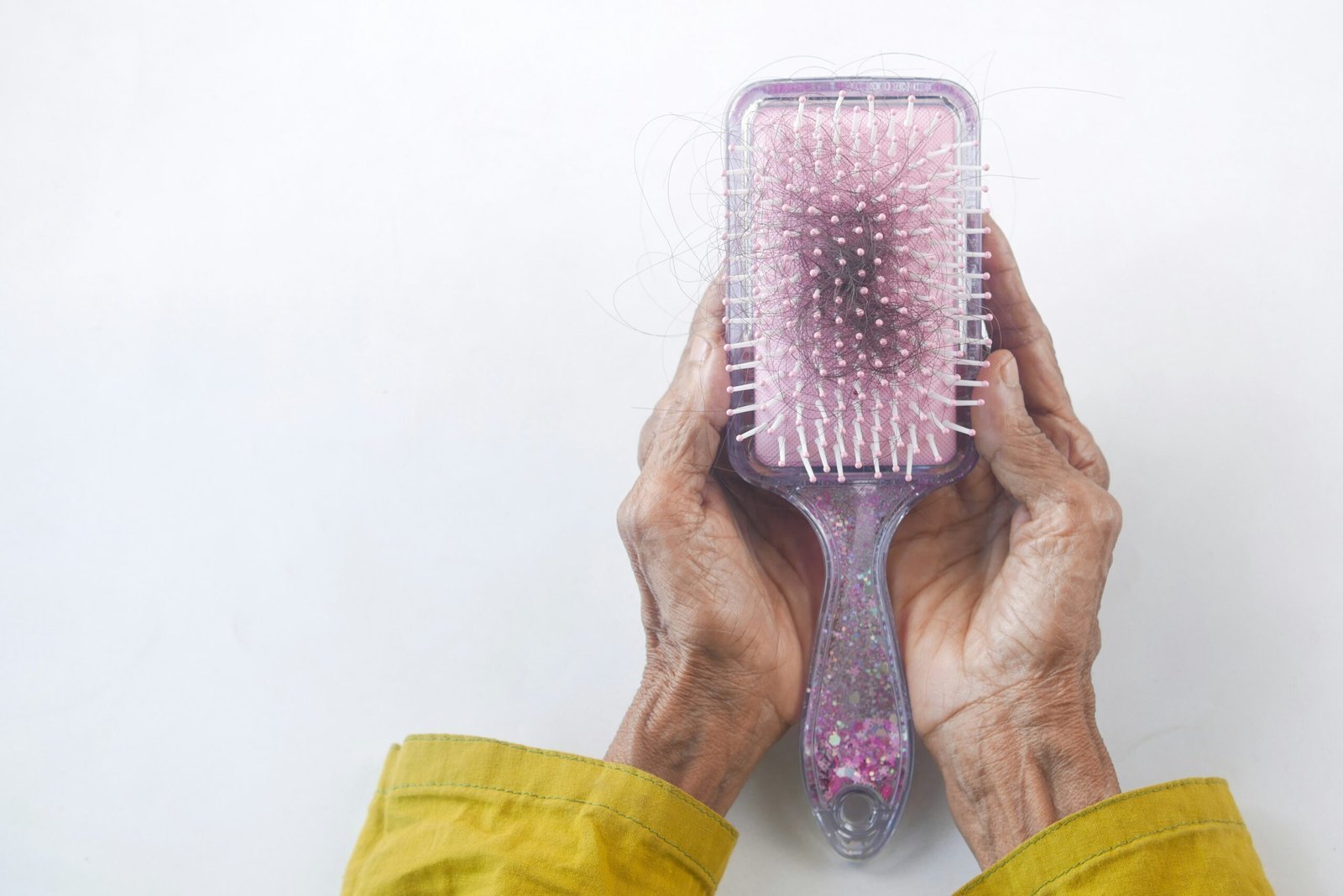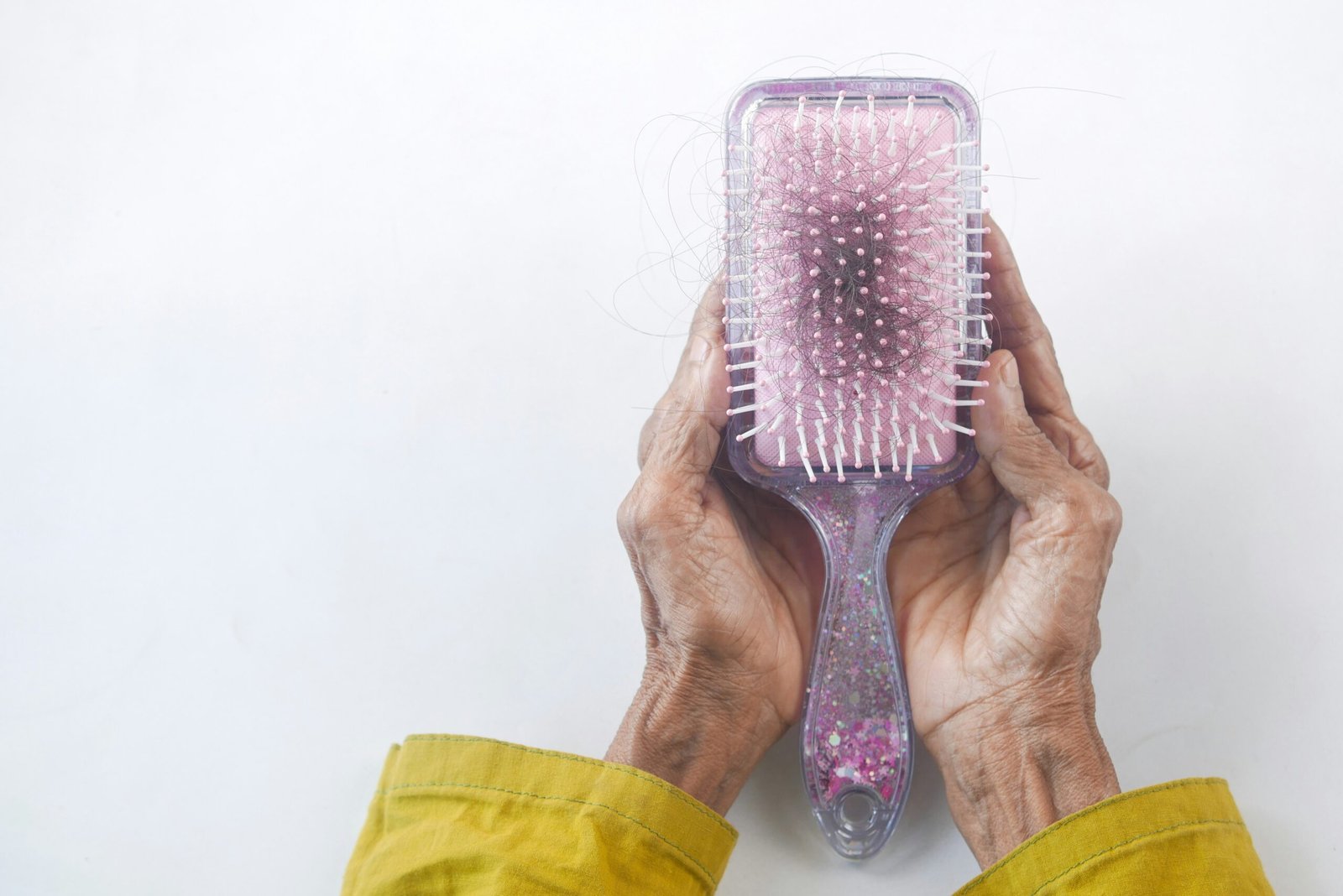
Introduction to Hair Loss
Hair loss, medically referred to as alopecia, is a condition that affects millions of individuals worldwide. It encompasses a variety of patterns and severities, ranging from mild thinning to complete baldness. Understanding hair loss is crucial for both men and women, as it can significantly impact one’s self-esteem and overall quality of life.
There are several types of alopecia, including androgenetic alopecia (commonly known as male or female pattern baldness), alopecia areata (an autoimmune condition causing patchy hair loss), and telogen effluvium (a temporary shedding of hair often triggered by stress or illness). Each type has distinct characteristics and causes, making it essential to identify the specific type of hair loss to determine the most effective treatment.
The emotional and psychological impact of hair loss cannot be understated. Many individuals experience feelings of embarrassment, anxiety, and depression as a result of their changing appearance. In some cases, hair loss can lead to social withdrawal and a diminished sense of self-worth. This underlines the importance of addressing hair loss not only as a physical condition but also as a mental and emotional challenge.
By gaining a comprehensive understanding of hair loss, individuals can better navigate their options for management and treatment. Awareness of the condition allows for informed decisions regarding both medical interventions and lifestyle adjustments that may mitigate the effects of hair loss. Moreover, recognizing the widespread nature of hair loss can foster a sense of community and reduce the stigma often associated with this condition.
This blog post aims to delve into the causes, treatments, and prevention strategies for hair loss, providing readers with valuable insights and practical advice. By demystifying the complexities of alopecia, we hope to empower individuals with the knowledge necessary to address and manage their hair loss effectively.
Common Causes of Hair Loss
Hair loss can be attributed to a variety of factors, which can broadly be categorized into genetic factors, hormonal changes, medical conditions, medications, and lifestyle factors. Understanding these causes is essential for identifying appropriate treatments and prevention strategies.
Genetic Factors: One of the most prevalent causes of hair loss is genetics. Androgenetic alopecia, commonly known as male or female pattern baldness, is a hereditary condition that affects both men and women. This type of hair loss follows a predictable pattern and is usually permanent, with men experiencing receding hairlines and women noticing thinning at the crown.
Hormonal Changes: Hormonal fluctuations can significantly impact hair growth cycles. Conditions such as pregnancy, childbirth, menopause, and thyroid imbalances can lead to temporary hair loss. For instance, postpartum hair loss is common as hormonal levels adjust after childbirth. Hormonal imbalances can disrupt the normal hair growth cycle, causing more follicles to enter the shedding phase.
Medical Conditions: Several medical conditions are linked to hair loss. Alopecia areata, an autoimmune disorder, causes patchy hair loss when the immune system attacks hair follicles. Scalp infections, such as ringworm, can also lead to hair thinning. Additionally, chronic illnesses like diabetes and lupus can have hair loss as a symptom.
Medications: Certain medications have hair loss as a side effect. Drugs used for cancer treatment, arthritis, depression, heart problems, and high blood pressure can cause temporary hair loss. Chemotherapy, in particular, is well-known for causing significant hair loss, which is typically reversible once treatment concludes.
Lifestyle Factors: Lifestyle choices can contribute to hair loss. Factors such as poor nutrition, extreme weight loss, and physical or emotional stress can all negatively impact hair health. Nutrient deficiencies, particularly of vitamins and minerals like iron and biotin, can weaken hair strands, leading to increased shedding. Stress can induce a condition known as telogen effluvium, where a significant number of hair follicles enter the resting phase prematurely.
In summary, the causes of hair loss are multifaceted and can range from genetic predispositions to lifestyle choices. While some causes lead to permanent hair loss, others are temporary and can be managed or reversed with appropriate interventions. Understanding these causes helps in tailoring effective treatment and prevention strategies.
Types of Hair Loss
Hair loss, medically known as alopecia, can manifest in various forms, each with distinct characteristics and progression patterns. Understanding the type of hair loss is crucial for determining the appropriate treatment and prevention strategies.
Androgenetic Alopecia: Commonly referred to as male or female pattern baldness, androgenetic alopecia is the most prevalent form of hair loss. It is characterized by a gradual thinning of hair, typically starting at the temples and crown for men, and diffuse thinning over the top of the scalp for women. This condition is hereditary and progresses over time, influenced by genetic and hormonal factors.
Alopecia Areata: This autoimmune disorder leads to sudden, patchy hair loss. The immune system mistakenly attacks hair follicles, resulting in circular bald patches on the scalp and other body parts. The severity and progression of alopecia areata can vary widely, with some individuals experiencing spontaneous regrowth and others facing more persistent or widespread hair loss.
Telogen Effluvium: Telogen effluvium occurs when a significant stressor, such as illness, surgery, or extreme stress, triggers a large number of hair follicles to enter the resting (telogen) phase simultaneously. This results in diffuse shedding of hair across the scalp. While telogen effluvium can be alarming, it is typically temporary, with normal hair growth resuming once the underlying cause is addressed.
Traction Alopecia: This type of hair loss is caused by prolonged tension on the hair shafts, often due to tight hairstyles like braids, ponytails, or extensions. Traction alopecia is characterized by thinning and breakage of hair along the hairline and other areas under stress. If detected early, changing hair styling practices can prevent further damage and allow hair to recover.
Recognizing the specific type of hair loss is the first step towards effective management. By identifying the symptoms and patterns associated with each type, individuals can seek appropriate medical advice and explore suitable treatments to address their hair loss concerns.
Diagnosing Hair Loss
Diagnosing hair loss effectively is critical for determining the appropriate treatment plan and mitigating further progression. The diagnostic process typically begins with a comprehensive physical examination. During this examination, a healthcare provider will closely inspect the scalp and hair to observe patterns of hair loss, which can provide initial clues about the underlying cause. In addition to the physical examination, a detailed medical history review is essential. This review encompasses any existing health conditions, medications, lifestyle factors, and family history of hair loss, all of which can contribute valuable insights.
To further pinpoint the cause, doctors often employ specific diagnostic tests. Blood tests are commonly ordered to assess for underlying medical conditions that might be contributing to hair loss, such as thyroid dysfunction, hormonal imbalances, or nutritional deficiencies. These tests can reveal significant health markers that directly impact hair health.
In some cases, a scalp biopsy may be necessary. This procedure involves removing a small section of scalp tissue to be examined under a microscope. A scalp biopsy can provide detailed information about the health of hair follicles and identify conditions like alopecia areata, scarring alopecia, or fungal infections. This diagnostic method is particularly useful when the cause of hair loss is not apparent from the physical examination and medical history alone.
Early diagnosis of hair loss is crucial for effective management and treatment. Prompt identification of the underlying cause allows for timely intervention, potentially halting or even reversing the progression of hair loss. To prepare for a diagnosis appointment, individuals should compile a comprehensive list of symptoms, note any recent changes in health or medications, and gather relevant family medical history. Clear communication with the healthcare provider about these factors can facilitate a more accurate and swift diagnosis.
By understanding and following the diagnostic process, patients can take proactive steps towards addressing hair loss and exploring suitable treatment options tailored to their specific condition.
Treatment Options for Hair Loss
Hair loss can be a distressing experience, but multiple treatment options are available that cater to different needs and preferences. Over-the-counter products, such as minoxidil, are widely used and can help increase hair density and reduce hair loss. However, results vary, and consistent use is required to maintain any gains. Minoxidil is generally well-tolerated, but some users may experience scalp irritation.
Prescription medications like finasteride work by inhibiting the hormone responsible for hair loss. This oral medication has shown significant efficacy in halting hair loss and promoting hair regrowth. Nonetheless, it is essential to consider potential side effects, such as decreased libido and an increased risk of prostate issues. Both minoxidil and finasteride are more effective in the earlier stages of hair loss.
Surgical procedures, particularly hair transplants, offer a more permanent solution. Hair transplants involve moving hair follicles from a donor area to the thinning or balding regions. While effective, this option can be costly and may require multiple sessions for optimal results. Recovery time and the risk of complications, such as infection or scarring, are additional considerations.
Non-surgical treatments are also gaining traction. Laser therapy, for instance, uses low-level lasers to stimulate hair follicles and encourage growth. Although the effectiveness of laser therapy can vary, it is a non-invasive option with minimal side effects. Similarly, platelet-rich plasma (PRP) therapy involves injecting a concentration of a patient’s own platelets into the scalp. PRP is believed to enhance hair follicle function and promote regrowth. While promising, PRP therapy requires several sessions and can be expensive.
Each treatment option has its pros and cons, and the choice largely depends on individual circumstances, including the extent of hair loss, budget, and tolerance for possible side effects. Consulting with a healthcare provider or a dermatologist can provide personalized recommendations tailored to one’s specific condition and preferences.
Natural Remedies and Lifestyle Changes
Addressing hair loss through natural remedies and lifestyle changes can be both effective and sustainable. One of the most impactful adjustments involves diet. Consuming a balanced diet rich in vitamins and minerals, such as iron, zinc, and biotin, can promote hair health. Foods like spinach, nuts, and fish are excellent sources of these nutrients. Additionally, incorporating protein-rich foods such as eggs and legumes can strengthen hair follicles and reduce hair thinning.
Essential oils have also been recognized for their potential in mitigating hair loss. Oils such as rosemary, lavender, and peppermint can be massaged into the scalp to stimulate hair growth. Scientific studies suggest that these oils may improve circulation and promote healthy hair follicles. However, it is important to dilute essential oils with a carrier oil, like coconut or jojoba oil, to prevent skin irritation.
Herbal supplements are another natural remedy worth considering. Saw palmetto, a popular herbal supplement, has been shown to inhibit the production of dihydrotestosterone (DHT), a hormone linked to hair loss. Another noteworthy supplement is ginseng, known for its ability to boost hair growth by improving scalp health. Always consult with a healthcare professional before starting any new supplement regimen to ensure it is appropriate for your individual health needs.
Managing stress is crucial for preventing hair loss, as chronic stress can disrupt the hair growth cycle. Techniques such as yoga, meditation, and deep breathing exercises can help reduce stress levels. Additionally, ensuring adequate sleep and regular physical activity can significantly improve overall health and hair vitality.
While natural remedies and lifestyle changes can offer benefits, it is essential to have realistic expectations. Hair growth is a gradual process, and results may vary depending on individual circumstances. Always consider the scientific backing of each remedy and consult with healthcare providers to create a comprehensive approach to mitigating hair loss.
Preventive Measures for Hair Loss
Preventing hair loss involves adopting a comprehensive approach that integrates proper hair care practices, a balanced diet, and a healthy lifestyle. Proper hair care is the cornerstone of maintaining strong and vibrant hair. This begins with gentle washing using a mild shampoo tailored to your hair type. Over-washing can strip the hair of its natural oils, leading to dryness and breakage, so it is advisable to find a balance that suits your individual needs. Conditioning is equally important, as it helps to moisturize and strengthen the hair shaft, reducing the risk of damage. Applying conditioner from mid-length to the ends is most effective, avoiding the scalp to prevent excess oiliness.
Minimizing the use of excessive heat and chemical treatments plays a crucial role in hair loss prevention. Tools such as hairdryers, straighteners, and curling irons can weaken hair over time if used frequently. When heat styling is necessary, using heat protectant products can significantly mitigate damage. Similarly, chemical treatments like coloring, perming, and relaxing should be approached with caution. If possible, these treatments should be spaced out to allow the hair time to recover.
A balanced diet rich in essential nutrients is vital for maintaining healthy hair. Proteins, vitamins, and minerals contribute significantly to hair strength and growth. Incorporating foods high in protein, such as lean meats, fish, eggs, and legumes, provides the building blocks for hair structure. Vitamins like A, C, D, and E, along with minerals such as zinc and iron, are also essential. Foods like leafy greens, nuts, seeds, and whole grains are excellent sources of these nutrients. Hydration plays a pivotal role as well, so ensure adequate water intake to keep hair hydrated from the inside out.
Regular exercise supports overall well-being, which in turn benefits hair health. Physical activity improves blood circulation, ensuring that hair follicles receive an adequate supply of nutrients and oxygen. Stress management through exercise can also prevent stress-related hair loss. Incorporating activities like yoga, jogging, or even brisk walking into your routine can make a tangible difference in maintaining healthy hair.
Living with Hair Loss: Emotional and Social Aspects
Hair loss can have profound emotional and social impacts, often affecting an individual’s self-esteem and overall mental well-being. The psychological ramifications of hair loss are varied and can include feelings of embarrassment, anxiety, and even depression. It is important to recognize these emotional challenges and seek appropriate support to navigate this journey effectively.
One effective way to cope with the psychological impact of hair loss is through counseling. Professional therapists can provide the tools and strategies needed to manage stress and emotional distress. Cognitive-behavioral therapy (CBT) has been particularly effective in helping individuals reframe negative thought patterns associated with hair loss. Additionally, joining support groups can provide a sense of community and shared experience. These groups offer a platform to share stories, advice, and encouragement, making the journey less isolating.
Boosting self-esteem and confidence is another crucial aspect of living with hair loss. Many individuals find that wearing wigs or hairpieces can significantly improve their self-image. Modern wigs are designed to look natural and can be styled according to personal preference, providing an immediate confidence boost. Moreover, exploring different styles and colors can become a fun and empowering experience.
Beyond aesthetic solutions, it is essential to focus on overall self-care and well-being. Engaging in regular physical activity, maintaining a healthy diet, and practicing mindfulness can improve mental health and foster a positive outlook. Additionally, embracing a supportive network of friends and family can provide emotional stability and encouragement.
Ultimately, living with hair loss does not mean the end of one’s confidence or social life. By seeking emotional support, utilizing practical solutions, and prioritizing self-care, individuals can navigate the challenges of hair loss with resilience and grace.


